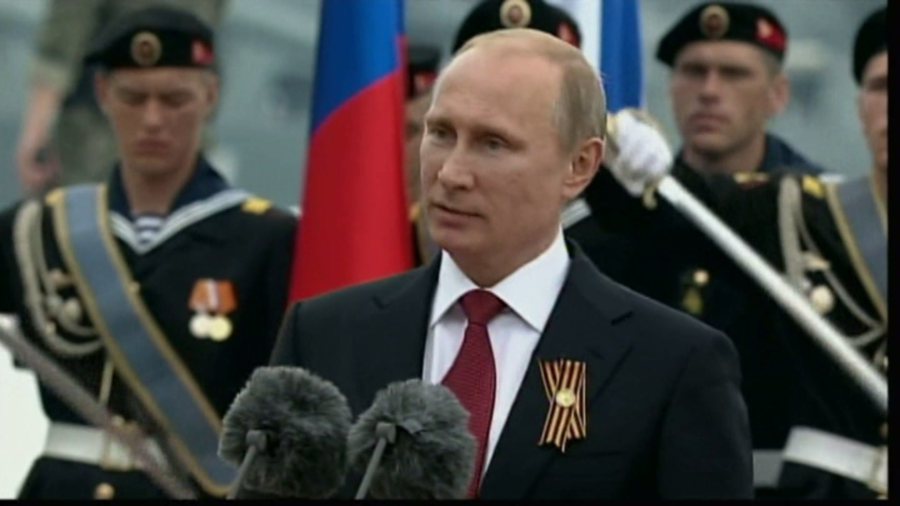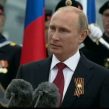
Possible Window of Opportunity for Diplomacy in the Ukrainian Crisis
Publication: Eurasia Daily Monitor Volume: 11 Issue: 96
By:

The Russian military seems to have begun a genuine pullback of combat forces, which had been poised for almost three months on the eastern borders of Ukraine. On May 19, President Vladimir Putin flew to Shanghai to oversee the signing of a grandiose agreement to sell Russian natural gas to China, in addition to a number of other deals intended to bring Moscow and Beijing closer in the face of Western sanctions. But prior to leaving for his trip, Putin chaired a Security Council meeting to discuss Ukraine. After the meeting’s conclusion, the Kremlin announced that Russian troops stationed at the Ukrainian border “will be withdrawn to their permanent bases” (https://www.interfax.ru/print.asp?sec=1448&id=376808). This was not the first such announced withdrawal of Russian forces from the border: On April 28, Russian Defense Minister Sergei Shoigu told his United States counterpart Chuck Hagel, “Russian forces have returned to their permanent bases” (https://function.mil.ru/news_page/country/more.htm?id=11922598@egNew). On May 7, Putin also announced, “Russia has withdrawn its forces from the Ukrainian border to places of regular exercises at training grounds” (https://news.kremlin.ru/transcripts/20973). Each time, officials of the North Atlantic Treaty Organization (NATO) countered those claims by noting that the Alliance had not seen any significant Russian moves to withdraw (https://www.interfax.ru/russia/377357).
Speaking to reporters in Shanghai after the signing of the gas deal, Putin tried to explain this inconsistency: “Russian troops deployed close to the border were withdrawn, but not too far,” but now are going “still further” to help “create favorable conditions for presidential elections in Ukraine,” on May 25. The withdrawal involves large numbers of soldiers and armor, according to Putin, and will take some time. Putin cautiously welcomed the coming elections as a step in the right direction, but demanded Ukrainian government forces simultaneously terminate all operations against pro-Russian activists (https://www.kremlin.ru/news/21064).
After the meltdown of President Viktor Yanukovych’s regime in Kyiv on February 25, the Russian Security Council approved military action. On February 26, the Russian military began massive military maneuvers to cover up the deployment of combat units on the eastern borders of Ukraine and in Crimea (https://www.interfax.ru/russia/txt/361371). The Ukrainian military in Crimea did not offer armed resistance, and the peninsula was annexed on March 18. Russian armed nationalist volunteers provided PR cover, posing as local “self-defense forces” (see EDM, March 24). Last April, the same scenario apparently began to develop in the eastern Ukrainian provinces of Donetsk and Luhansk, as armed pro-Russian separatists occupied government buildings, declared “independent people’s republics” and asked for Putin to send in “peacekeepers” (see EDM, April 24).
The Kyiv authorities tried desperately to reinforce their dilapidated and demoralized army and paramilitary forces to counter the armed separatists and a possible Russian invasion. On April 24, Shoigu announced: “Battalion tactical groups of the Southern and Western military districts have begun exercises in the proximity of the Ukrainian border, ready to go into action, supported by airpower.” Shoigu accused Kyiv of concentrating on the border some 11,000 soldiers with armor and airpower against just some 2,000 badly armed rebels. “The balance of forces is tilted,” declared Shoigu, “We are forced to respond” (https://function.mil.ru/news_page/country/more.htm?id=11921527@egNews). An all-out offensive seemed inevitable, but did not materialize. The Russian troops massed for action withdrew from the brink and are now apparently moving back to home bases in different parts of Russia. On May 21, according to the Russian defense ministry, four trainloads of armor and other heavy equipment left the border area and 15 planeloads of soldiers were flown out via heavy Il-76 transport jets (https://www.interfax.ru/russia/377357).
Apparently, the Kremlin decided a full-scale invasion of Ukraine is too risky for a possible variety of reasons: pending Western punitive sanctions, international isolation, becoming bogged down while occupying a partially hostile population, potential sky-high costs of integrating a Ukrainian rustbelt of dilapidated old coal mines and steel mills, and so on. This decision (or indecision) had consequences: Since the troops did not go in, most of them are now required to return to home bases. The window of opportunity to go into eastern Ukraine with tanks may be closing, while breathing space for diplomacy may have opened.
The Russian army has been using battalion tactical groups (BTG) as its standard field fighting formation in wars in Chechnya and against Georgia, instead of standard Soviet regiments and divisions. An army division or brigade forms a BTG as a provisional combined-forces separate combat unit, including infantry, armor, heavy guns, anti-aircraft capabilities and sappers. Plans have been announced to recruit more contract soldiers to make the Russian Airborne Troops (VDV) an all-volunteer force by 2020. But at present there are some 300,000 conscripts in the armed forces and just over 200,000 contract soldiers. The elite VDV is only 60-percent volunteer (ITAR-TASS, May 17). The backbone of the BTGs poised on the Ukrainian border are conscripts that were called up a year ago and are now awaiting demobilization. A decree (ukaz) by Putin was published on April 1, announcing a new spring call-up of 150,000 conscripts and subsequent mustering out of an equivalent number of experienced one-year serving soldiers. Keeping the conscripts in the BTGs on the Ukrainian border much longer, while their comrades all over Russia are demobilized, would have been organizationally and politically impossible: they would begin demanding to be sent home, and morale would slip. The tanks and other heavy equipment of the BTGs must also be taken to their home bases for maintenance. While officers and contract soldiers must receive leave and be replaced.
In essence, the BTGs from the Ukrainian border must be withdrawn, dissolved and formed anew on the basis of the brigades and divisions from which they came, with new conscripts that were called up last fall. It has been announced that the withdrawal of the BTGs will be complete by June 1, and the formation of reformed units will commence (https://www.rg.ru/2014/05/21/poligon-site.htm).
This leaves the separatists in Donetsk and Luhansk in a tight spot, desperately trying to provoke Moscow into intervening. The self-appointed leader of the Luhansk “people’s republic,” Valery Bolotov, has declared martial law, a mobilization of all able bodied men from 18 to 45 and once again demanded a Russian intervention “to prevent a humanitarian catastrophe” (https://www.interfax.ru/377431). Attempts have also been made to take over Ukrainian border posts, and the interim prime minister, Arseniy Yatsenyuk, has demanded a United Nations Security Council meeting, accusing Russia of sponsoring attacks and calling the Russian troop withdrawal a sham (https://www.pravda.com.ua/rus/news/2014/05/22/7026102/). If the present Russian military pause does not lead to a genuine de-escalation, by this July the Russian army may be ready with fresh BTGs for massive offensive action.




